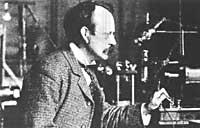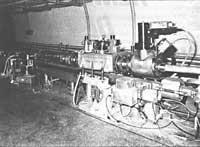Joseph John Thomson
1990/07/01 Azkune Mendia, Iñaki - Elhuyar Fundazioa Iturria: Elhuyar aldizkaria
English physicist born at Cheetham Hall near Manchester on December 18, 1856. At the age of fourteen he began his engineering studies at the Manchester school, but soon he was given the tendency to physics.
In 1876 he travelled to Cambridge with a scholarship and spent the years there until his death. He finished his career as a mathematician. Then in 1884, when he was only twenty-six, he was professor of physics for the retirement of John Rayleigh. He assumed responsibility for the Cavendish laboratory and was a good director in subatomic physics in the 20th century. At the beginning of the 20th century Britain was a pioneer.
Thomson began to work on Maxwell's electromagnetic radiation theory and then on cathodic rays. These rays were a new form of radiation, as they were not electromagnetic. William Crookes and other physicists demonstrated that cathodic rays were negatively charged particles, as the magnetic field diverted the rays. This test was not complete. To do this, the electric field should also divert the rays if they were formed by really charged particles.

Thomson demonstrated in 1897 that the electric field diverted cathodic rays using the tubes with the most perfect fault possible. Later it has been considered that cathodic rays are negatively charged particles. Thomson also measured the relationship between load and mass of cathodic ray particles. According to Faraday's electrochemical laws, if the electric charge was the minimum of the ions, the particle mass of the cathodic rays was much smaller than that of the hydrogen atom. Therefore, the particles of the cathodic rays were much smaller than the atoms and for the first time we could start talking about subatomic particles.
These subatomic particles were accepted as electrical current units. George Stoney had proposed the word electron for the hypothetical electrical unit and Hendrik Lorentz applied it to cathodic ray particles. As the last trial to demonstrate the presence of these particles in cathodic rays was conducted by Thomson, who demonstrated that the size of the particles was smaller than the atom, the discovery of the electron is attributed to Thomson. Today we also know that the mass of the electron is 1837 times smaller than that of the hydrogen atom.
For Thomson the electron was a universal component of matter. He therefore formulated one of the first theories on the internal structure of the atom. For Thomson the atom was a sphere of positive electricity in which negative electrons were located neutralizing the positive charge. This initial theory was soon replaced by another one devised by Thomson's student Ernest Rutherford. Rutherford's theory was logically more complete and useful.
In 1906 Thomson received the Nobel Prize in Physics for his work with the electron. In 1908 he obtained the title of Sir. In the field of the awards it must be said that Thomson taught famous students and seven of them subsequently received the Nobel Prize.
Since 1906 he took over the Thomson ray channels, the rays that Eugen Goldstein found twenty years earlier. By forming a positively charged ion flow, he called them positive rays.
Thomson diverted the ray channels by magnetic and electric fields. Ions with different load/mass ratio printed different aspects of the photographic plate. In 1912 he was able to verify that the neon gas ions fell to two distinct points, as if it were a mixture of ions of two different types, as if it were a mixture of ions of different charge, mass or both. Frederick Soddy suggested that there could be isotopes. Isotopes are atoms whose mass is exclusively atomic.
Thomson collected in his essay the traces of what the neon could contain isotopes. Later, his disciple Francis William Aston continued these investigations, clearly demonstrating the existence of isotopes.
Thomson died in Cambridge on 30 August 1940, the eve of the famous battle of England. His body was buried in Westminster Abbey next to Newton's tomb more than fifty years ago.

Gai honi buruzko eduki gehiago
Elhuyarrek garatutako teknologia




